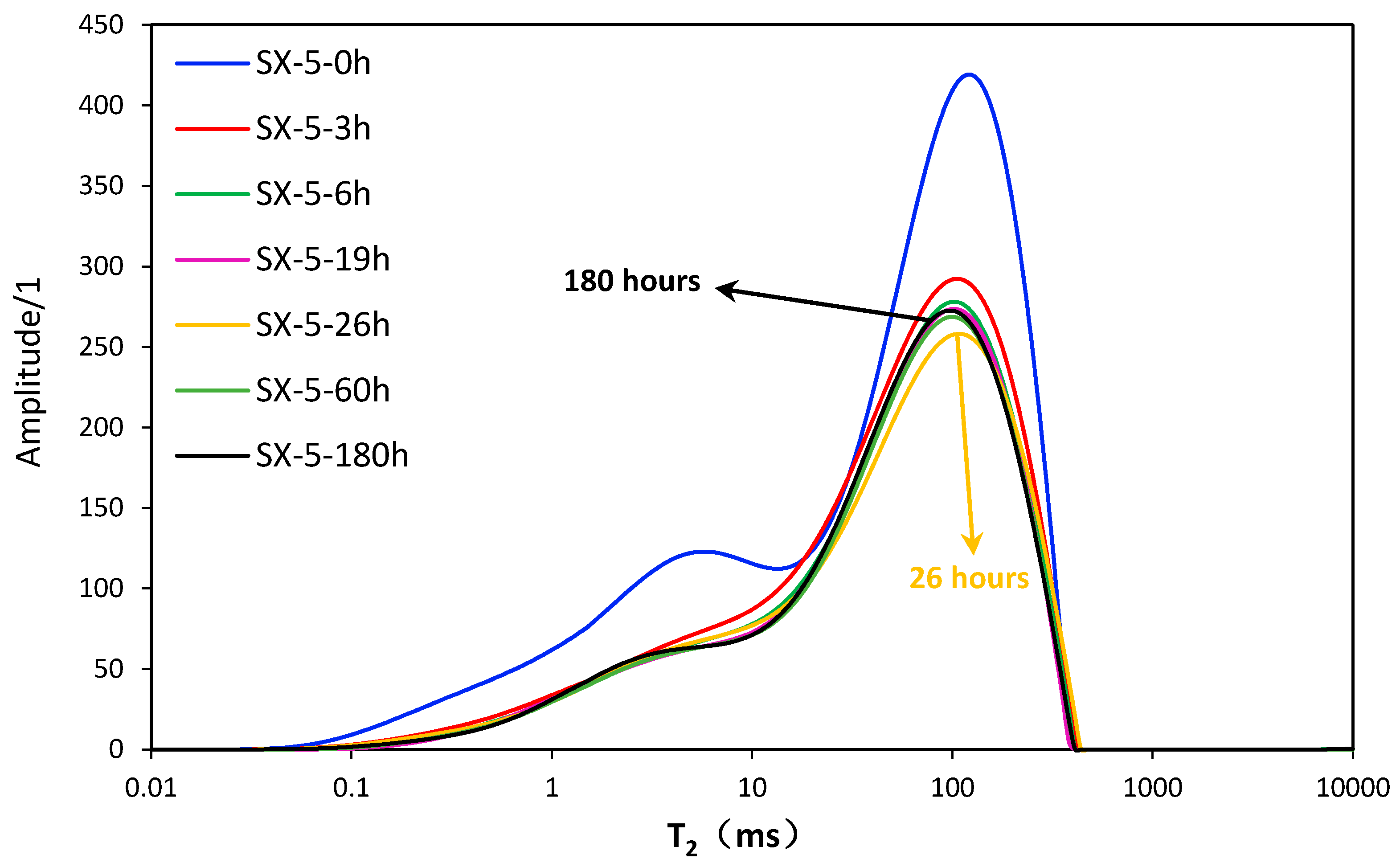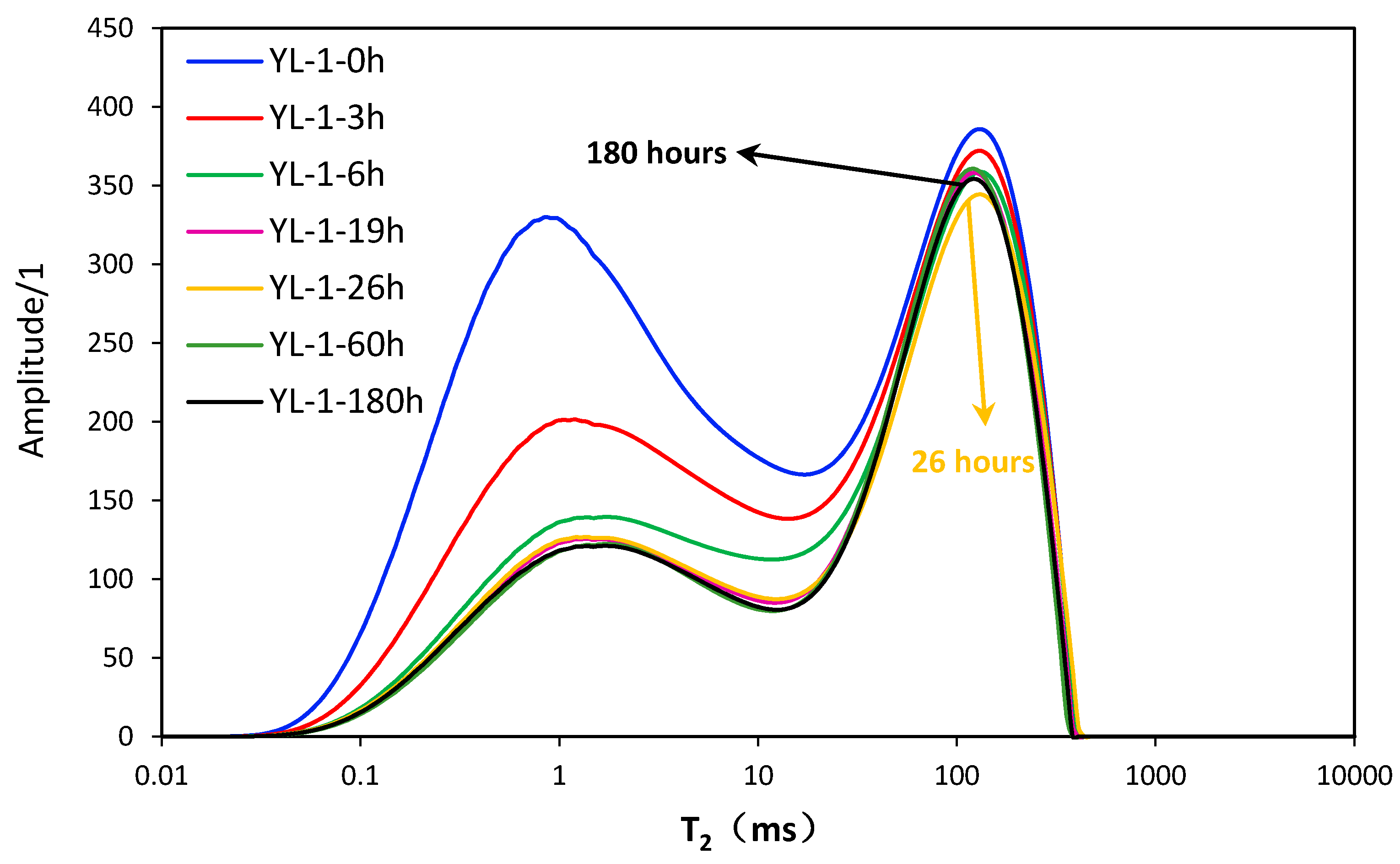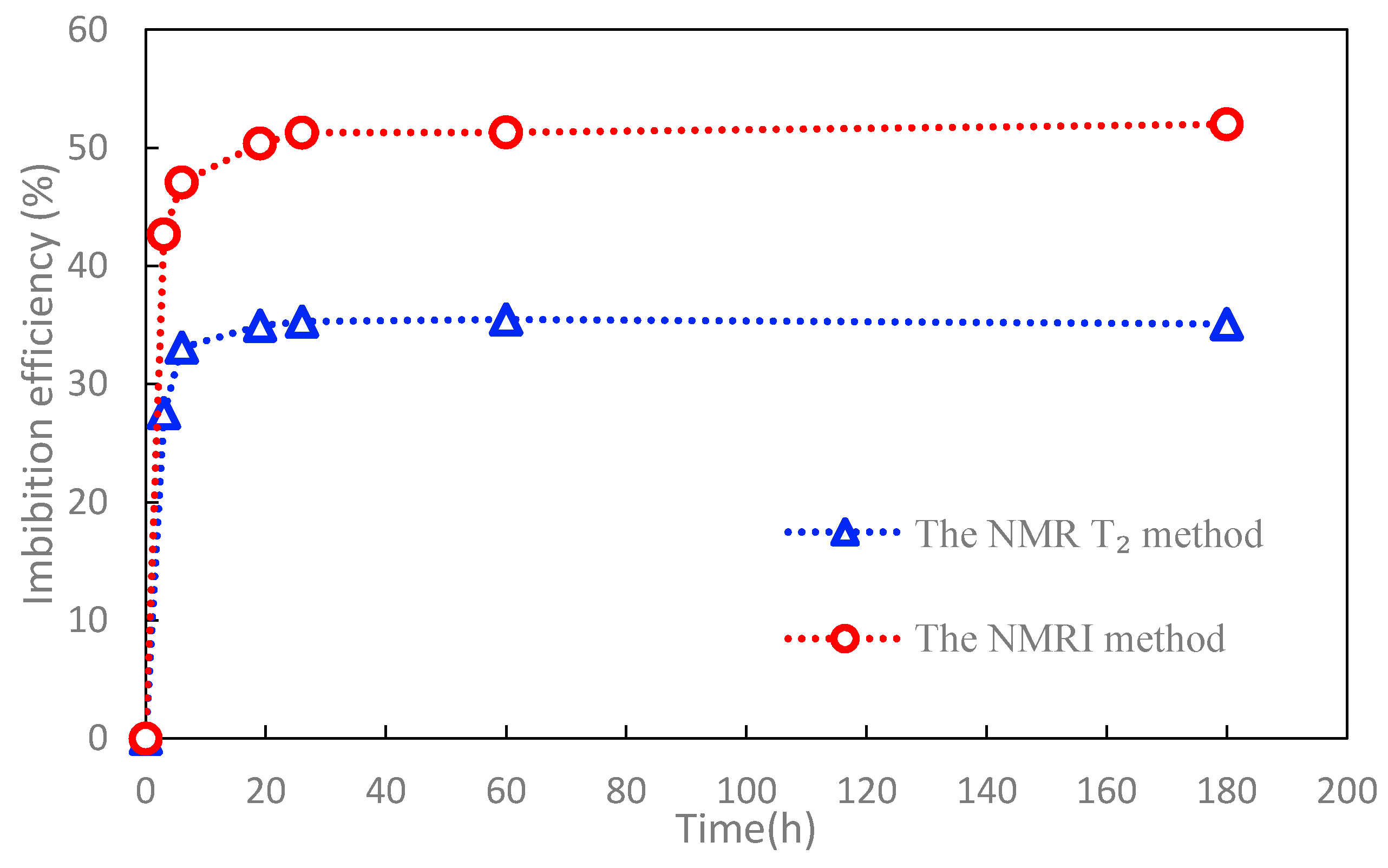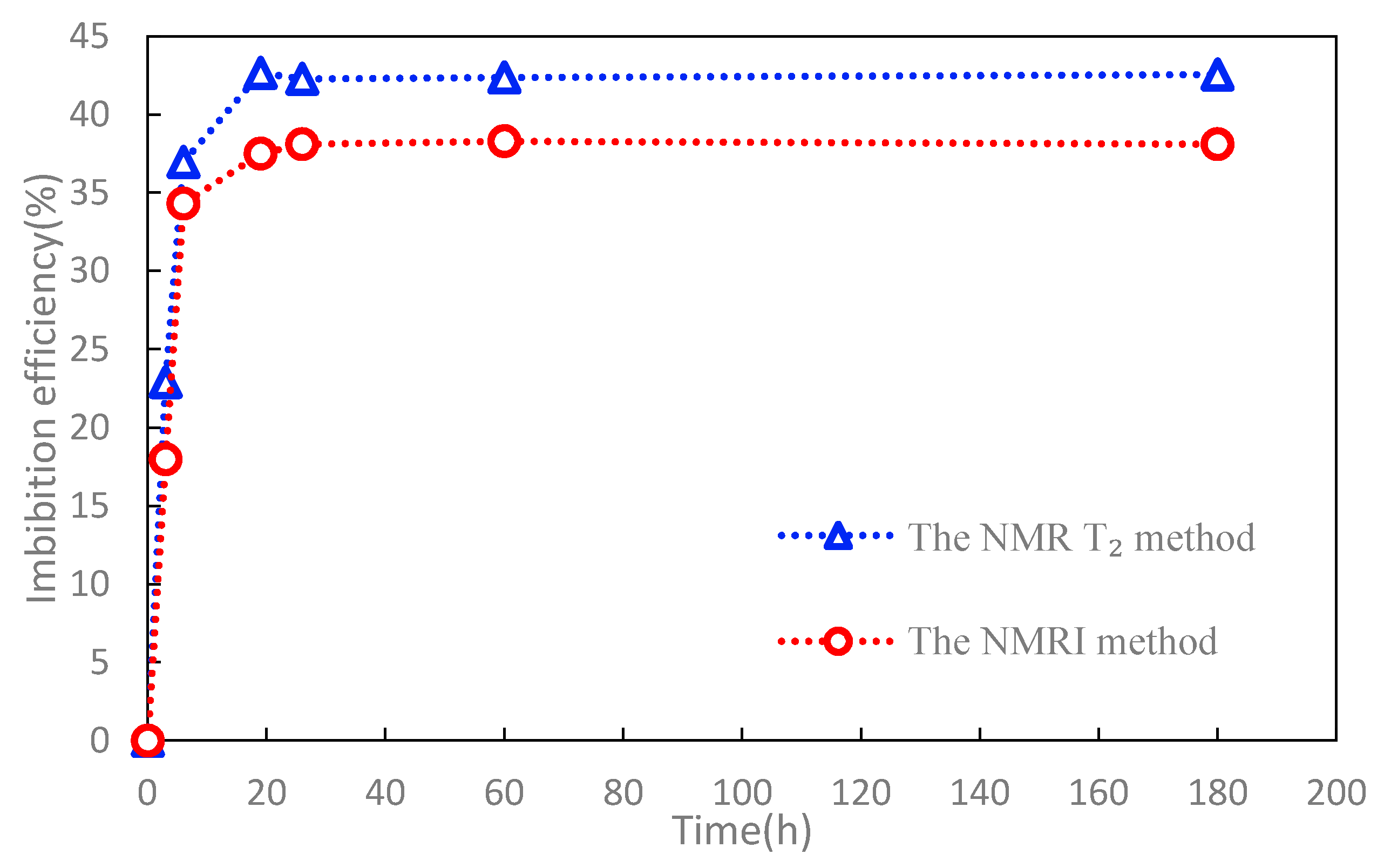Investigation on the Application of NMR to Spontaneous Imbibition Recovery of Tight Sandstones: An Experimental Study
Abstract
:1. Introduction
2. Methodology
2.1. NMR T2
2.2. NMRI
3. Experimental Materials
3.1. Samples
3.2. Fluids
3.3. Experimental Instrument
3.4. Experimental Procedure
4. Results and Discussion
4.1. NMR T2 under Saturated Condition
4.2. Remaining Oil Distributions after Imbibition
4.3. Imbibition Front
4.4. Recommended Methods to Calculate Imbibition Recovery
5. Conclusions
Author Contributions
Acknowledgments
Conflicts of Interest
References
- Jia, C.Z.; Zou, C.N.; Li, J.Z.; Li, D.H.; Zheng, M. Assessment criteria, main types, basic features and resource prospects of the tight oil in Chin. Acta Petrol. Sin. 2012, 33, 343–350. [Google Scholar]
- Chen, M.Q.; Cheng, L.S.; Cao, R.Y.; Lyu, C.H. A Study to Investigate Fluid-Solid Interaction Effects on Fluid Flow in Micro Scales. Energies 2018, 11, 2197. [Google Scholar] [CrossRef]
- Lyu, C.; Ning, Z.; Wang, Q.; Chen, M. Application of NMR T2 to Pore Size Distribution and Movable Fluid Distribution in Tight Sandstones. Energy Fuels 2018, 32, 1395–1405. [Google Scholar] [CrossRef]
- Novlesky, A.; Kumar, A.; Merkle, S. Shale Gas modeling workflow: From microseismic to simulation-A horn river case study. In Proceedings of the Canadian Unconventional Resources Conference, Calgary, AB, Canada, 15–17 November 2011. [Google Scholar]
- Yang, L.; Ge, H.; Shi, X. The effect of microstructure and rock mineralogy on water imbibition characteristics in tight reservoirs. J. Nat. Gas Sci. Eng. 2016, 34, 1461–1471. [Google Scholar] [CrossRef]
- Meng, M.; Ge, H.; Ji, W. Monitor the process of shale spontaneous imbibition in co-current and counter-current displacing gas by using low field nuclear magnetic resonance method. J. Nat. Gas Sci. Eng. 2015, 27, 336–345. [Google Scholar] [CrossRef]
- Olafuyi, O.A.; Cinar, Y.; Knackstedt, M.A. Spontaneous imbibition in small cores. In Proceedings of the 2007 SPE Asia Pacific Oil & Gas Conference and Exhibition, Jakarta, Indonesia, 30 October–1 November 2007. [Google Scholar]
- Wei, W.; Cai, J.; Xiao, J.; Meng, Q.; Xiao, B.; Han, Q. Kozeny-Carman constant of porous media: Insights from fractal-capillary imbibition theory. Fuel 2018, 234, 1373–1379. [Google Scholar] [CrossRef]
- Li, C.X.; Shen, Y.H.; Ge, H.K.; Su, S.; Yang, Z.H. Analysis of spontaneous imbibition in fractal tree-like network system. Fractals 2016, 24. [Google Scholar] [CrossRef]
- Cai, J.; Perfect, E.; Cheng, C. Generalized modeling of spontaneous imbibition based on Hagen-Poiseuille flow in tortuous capillaries with variably shaped apertures. Langmuir 2014, 30, 5142–5151. [Google Scholar] [CrossRef] [PubMed]
- Alomair, O.A. New Experimental Approach for Measuring Drainage and Spontaneous Imbibition Capillary Pressure. Energy Fuels 2009, 23, 260–271. [Google Scholar] [CrossRef]
- Lyu, C.; Ning, Z.; Chen, M.; Wang, Q. Experimental study of boundary condition effects on spontaneous imbibition in tight sandstones. Fuel 2019, 235, 374–383. [Google Scholar] [CrossRef]
- Li, C.X.; Shen, Y.H.; Ge, H.K.; Yang, Z.H.; Su, S.; Ren, K.; Huang, H.Y. Analysis of capillary rise in asymmetric branch-like capillary. Fractals 2016, 24, 15–22. [Google Scholar] [CrossRef]
- Mason, G.; Fernø, M.A.; Haugen, Å.; Morrow, N.R.; Ruth, D.W. Spontaneous Counter-Current Imbibition outwards from a HemiSpherical Depression. J. Pet. Sci. Eng. 2012, 90–91, 131–138. [Google Scholar] [CrossRef]
- Cai, J.C.; Yu, B.M.A. Discussion of the Effect of Tortuosity on the Capillary Imbibition in Porous Media. Transp. Porous. Med. 2011, 89, 251–263. [Google Scholar] [CrossRef]
- Zhou, D.; Jia, L.; Kamath, J. Scaling of counter-current imbibition processes in low-permeability porous media. J. Petrol. Sci. Eng. 2002, 33, 61–74. [Google Scholar] [CrossRef]
- Zhou, D.; Jia, L.; Kamath, J. An Investigation of Counter-Current Imbibition Processes in Diatomite. In Proceedings of the SPE Western Regional Meeting, Bakersfield, CA, USA, 26–30 March 2001. [Google Scholar]
- Li, J.S. The Effect of Surfactant System on Imbibition Behavior. Ph.D. Thesis, Institute of Porous flow and Fluid Mechanics of Chinese Academy of Sciences, Beijing, China, 2006. [Google Scholar]
- Coates, G.R.; Xiao, L.; Prammer, M.G. NMR Logging Principles and Applications, 1st ed.; Halliburton Energy Services: Houston, TX, USA, 1999; ISBN 978-0967902609. [Google Scholar]
- Al-Yaseri, A.Z.; Lebedev, M.; Vogt, S.J. Pore-scale analysis of formation damage in Bentheimer sandstone with in-situ NMR and micro-computed tomography experiments. J. Petrol. Sci. Eng. 2015, 106, 48–57. [Google Scholar] [CrossRef]
- Morriss, C. Core analysis by low-field NMR. Log Anal. 1997, 38, 84–93. [Google Scholar]
- Yao, Y.; Liu, D.; Che, Y. Petrophysical characterization of coals by low-field nuclear magnetic resonance (NMR). Fuel 2010, 89, 1371–1380. [Google Scholar] [CrossRef]
- Baldwin, B.A.; Spinler, E.A. In situ saturation development during spontaneous imbibition. J. Petrol. Sci. Eng. 2002, 35, 23–32. [Google Scholar] [CrossRef]
- Li, M.; Romerozerón, L.; Marica, F. Polymer Flooding Enhanced Oil Recovery Evaluated with Magnetic Resonance Imaging and Relaxation Time Measurements. Energy Fuels 2017, 31, 4904–4914. [Google Scholar] [CrossRef]
- Song, Y.; Wang, S.; Yang, M. MRI measurements of CO2-CH4 hydrate formation and dissociation in porous media. Fuel 2015, 140, 126–135. [Google Scholar] [CrossRef]
- Jiang, T.; George Hirasaki, A.; Miller, C.; Moran, K.; Fleury, M. Diluted Bitumen Water-in-Oil Emulsion Stability and Characterization by Nuclear Magnetic Resonance (NMR) Measurements. Energy Fuels 2007, 21, 1325–1336. [Google Scholar] [CrossRef]
- Lai, F.P.; Li, Z.P.; Wei, Q.; Zhang, T.T.; Zhao, Q.H. Experimental Investigation of Spontaneous Imbibition in a Tight Reservoir with Nuclear Magnetic Resonance Testing. Energy Fuels 2016, 30, 8932–8940. [Google Scholar] [CrossRef]
- Chen, T.; Yang, Z.; Ding, Y.; Luo, Y.T.; Qi, D.; Wei, L.; Zhao, X.L. Waterflooding Huff-n-puff in Tight Oil Cores Using Online Nuclear Magnetic Resonance. Energies 2018, 11, 1524. [Google Scholar] [CrossRef]
- Oren, P.E.; Bakke, S.; Arntzen, O.J. Extending Predictive Capabilities to Network Models. SPE J. 1998, 3, 324–336. [Google Scholar] [CrossRef]
- Ruth, D.; Mason, G.; Morrow, N.R. A Numerical Study of the Influence of Sample Shape on Spontaneous Imbibition. In Proceedings of the International Symposium of the Society of Core Analysts, Pau, France, 21–24 September 2003. [Google Scholar]
- Li, H.; Guo, H.; Yang, Z. Tight oil occurrence space of Triassic Chang 7 Member in Northern Shaanxi Area, Ordos Basin, NW China. Petrol. Explor. Dev. 2015, 42, 434–438. [Google Scholar] [CrossRef]
- Valvatne, P.H.; Blunt, M.J. Predictive pore-scale modeling of two-phase flow in mixed wet media. Water Resour. Res. 2004, 40, 187–187. [Google Scholar] [CrossRef]
- Kleinberg, R.L.; Farooqui, S.A. T1/T2 ratio and frequency dependence of NMR relaxation in porous sedimentary rocks. J. Colloid. Interface Sci. 1993, 158, 195–198. [Google Scholar] [CrossRef]
- Kleinberg, R.L.; Straley, C.; Kenyon, W.E.; Akkurt, R.; Farooqui, S.A. Nuclear magnetic resonance of rocks: T1 vs. T2. In Proceedings of the SPE Annual Technical Conference and Exhibition, Houston, TX, USA, 3–6 October 1993. [Google Scholar]







| Sample | Petrophysical Property | X-ray Results/% | |||||||||
|---|---|---|---|---|---|---|---|---|---|---|---|
| L/cm | R/cm | K/mD | ϕ/% | So/% | θ/° | Qz | Pl | Cal | Dol | TCCM | |
| SX-5 | 3.99 | 2.52 | 0.21 | 9.7 | 96.5 | 49.3 | 69.4 | 8.5 | 1.1 | 5.0 | 16 |
| YL-1 | 3.83 | 2.52 | 0.89 | 10.2 | 98.3 | 40.5 | 82.7 | - | - | - | 17.3 |
© 2018 by the authors. Licensee MDPI, Basel, Switzerland. This article is an open access article distributed under the terms and conditions of the Creative Commons Attribution (CC BY) license (http://creativecommons.org/licenses/by/4.0/).
Share and Cite
Lyu, C.; Wang, Q.; Ning, Z.; Chen, M.; Li, M.; Chen, Z.; Xia, Y. Investigation on the Application of NMR to Spontaneous Imbibition Recovery of Tight Sandstones: An Experimental Study. Energies 2018, 11, 2359. https://doi.org/10.3390/en11092359
Lyu C, Wang Q, Ning Z, Chen M, Li M, Chen Z, Xia Y. Investigation on the Application of NMR to Spontaneous Imbibition Recovery of Tight Sandstones: An Experimental Study. Energies. 2018; 11(9):2359. https://doi.org/10.3390/en11092359
Chicago/Turabian StyleLyu, Chaohui, Qing Wang, Zhengfu Ning, Mingqiang Chen, Mingqi Li, Zhili Chen, and Yuxuan Xia. 2018. "Investigation on the Application of NMR to Spontaneous Imbibition Recovery of Tight Sandstones: An Experimental Study" Energies 11, no. 9: 2359. https://doi.org/10.3390/en11092359
APA StyleLyu, C., Wang, Q., Ning, Z., Chen, M., Li, M., Chen, Z., & Xia, Y. (2018). Investigation on the Application of NMR to Spontaneous Imbibition Recovery of Tight Sandstones: An Experimental Study. Energies, 11(9), 2359. https://doi.org/10.3390/en11092359





